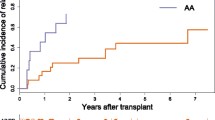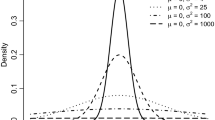Abstract
Patients are frequently exposed to failure from several mutually exclusive causes, leading to a competing risk setting. Standard methods concerning the effects of covariates on the cause-specific hazards assume constant hazard ratios across time. This assumption, however, is violated in several applications. To address this issue and test the effect of covariates on multiple risks, we develop a new regression model allowing for nonconstant hazard ratios over time. The proposed model allows explicit specification of the short-term and long-term covariate effects, which can be of clinical interest. We develop a statistically efficient nonparametric likelihood methodology for estimation and inference concerning the parameters of interest and compare it to the existing methods. We investigate the performances of the proposed methods using simulations and apply them to a European study on a registry cohort of patients with acute leukemia undergoing bone marrow transplantation. Our proposed model detects the differences in short-term and long-term risks of primary relapse between patients with and without acute lymphoblastic leukemia.





Similar content being viewed by others
References
Cox DR (1972) Regression model and life-tables (with discussion). J R Stat Soc Ser B 34:187–220
Passweg JR, Baldomero H, Gratwohl A, Bregni M, Cesaro S, Dreger P, Witte TD, Farge-Bancel D, Gaspar B, Marsh J, Mohty M, Peters C, Tichelli A, Velardi A, de Elvira CR, Falkenburg F, Sureda A, Madrigal A (2012) The EBMT activity survey: 1990–2010. Bone Marrow Transpl 47:906–923
Zucker DM, Karr AF (1990) Nonparametric survival analysis with timedependent covariate effects: a penalized partial likelihood approach. Ann Stat 18:329–353
Murphy SA, Sen PK (1991) Time-dependent coefficients in a Cox-type regression model. Stoch Process Appl 39:153–180
Murphy SA (1993) Testing for a time dependent coefficient in Cox’s regression model. Scand J Stat 20:35–50
Martinussen T, Scheike TH, Skovgaard IM (2002) Efficient estimation of fixed and time-varying covariate effects in multiplicative intensity models. Scand J Stat 29:57–74
Winnett A, Sasieni P (2003) Iterated residuals and time-varying covariate effect in Cox regression. J R Stat Soc Ser B 65:473–488
Cai Z, Sun Y (2003) Local linear estimation for time-dependent coefficients in Cox regression models. Scand J Stat 30:93–111
Tian L, Zucker D, Wei LJ (2005) On the Cox model with time-varying regression coefficients. J Am Stat Assoc 100:172–183
Martinussen T, Scheike TH (2006) Dynamic regression models for survival data. Springer, New York
Peng L, Huang Y (2007) Survival analysis with temporal covariate effects. Biometrika 94:719–733
Yang S, Prentice R (2005) Semiparametric analysis of short-term and long-term hazard ratios with two-sample survival data. Biometrika 92(1):1–17
Diao G, Zeng D, Yang S (2013) Efficient semiparametric estimation of short-term and long-term hazard ratios with right-censored data. Biometrics 69:840–849
Andersen PK, Abildstrom SZ, Rosthoj S (2002) Competing risks as a multi-state model. Stat Methods Med Res 11:203–215
Andersen PK (2002) Multi-state models. Stat Methods Med Res 11:89–90
Andersen PK, Keiding N (2002) Multi-state models for event history analysis. Stat Methods Med Res 11:91–115
Putter H, Fiocco S, Geskus R (2007) Tutorial in biostatistics: competing risks and multi-state models. Stat Med 26:2389–2430
Beyersmann J, Allignol A, Schumacher M (2012) Competing risks and multistate models with R. Springer, New York
Murphy Susan A (1994) Consistency in a proportional hazards model incorporating a random effect. Ann Stat 22(2):712–731
Press WH, Teukolsky SA, Vetterling WT, Flannery BP (1992) Numerical recipes in C: the art of scientific computing, 2nd edn. Cambridge University Press, Cambridge
Bickel Peter J, Klassen Chris A J, Ritov Ya’acov, Wellner Jon A (1993) Efficient and adaptative estimation for semiparametric models. Springer series in statistics. Springer, New York
Katsahian S, Porcher R, Mary JY, Chevret S (2004) The graft-versus-leukaemia effect after allogeneic bone-marrow transplantation: assessment through competing risks approaches. Stat Med 23:3851–3863
Nelson W (1969) Hazard plotting for incomplete failure data. J Qual Technol 1:27–52
Nelson W (1972) Theory and applications of hazard plotting for censored failure data. Technometrics 14:945–965
Aalen OO (1978) Nonparametric inference for a family of counting processes. Ann Stat 6:701–726
Gray RJ (1988) A class of k-sample tests for comparing the cumulative incidence of a competing risk. Ann Stat 16:1141–1154
Peng L, Fine JP (2007) Regression modeling of semicompeting risks data. Biometrics 63:96–108
Lin DY, Wei LJ, Ying Z (1993) Checking the Cox model with cumulative sums of Martingale-based residuals. Biometrika 80:557–572
van der Vaart A, Wellner J (1996) Weak convergence and empirical processes: with applications to statistics. Springer, New York
Acknowledgements
The authors thank Geoffray Bizouard for his help in writing the R program that implements the proposed methods. The authors are also grateful to the reviewers for their helpful comments that improved the presentation of the paper.
Author information
Authors and Affiliations
Corresponding author
Appendix: Asymptotic properties of the proposed NPMLEs
Appendix: Asymptotic properties of the proposed NPMLEs
In this Appendix, we outline the asymptotic properties of the proposed NPMLEs. Let \(\varvec{\xi }_0=\{({\varvec{\beta }}_{0j},\varvec{\gamma }_{0j}), \quad j=1, \ldots, k\}\) and \(\varvec{\varLambda }_0 = \{\varLambda _{0j}, \quad j=1,\ldots,k\}\) denote the true parameters of \(\varvec{\xi }= \{({\varvec{\beta }}_j,\varvec{\gamma }_j),\quad j=1,\ldots,k\}\) and \(\varvec{\varLambda }= \{\varLambda _j,\quad j=1,\ldots,k\}\), respectively. Let \(\widehat{\varvec{\xi }} = \{(\widehat{{\varvec{\beta }}}_{j},\widehat{\varvec{\gamma }}_{j}),\quad j=1,\ldots,k\}\) and \(\widehat{\varvec{\varLambda }} = \{\widehat{\varLambda }_{j}, \quad j=1,\ldots, k\}\) denote the proposed NPMLEs. To establish the consistency and asymptotic normality of the proposed NPMLEs, denoted by \(\widehat{\varvec{\xi }} = \{(\widehat{{\varvec{\beta }}}_{j},\widehat{\varvec{\gamma }}_{j})\quad j=1,\ldots,k\}\) and \(\widehat{\varvec{\varLambda }} = \{\widehat{\varLambda }_{j}\quad j=1,\ldots, k\}\), the following regularity conditions are needed:
-
(C1)
If there exist a constant c and a constant vector \(\mathbf{b}\) such that
$$\mathbf{b}^T\mathbf{X}=c,$$with probability one, then \(c=0\) and \(\mathbf{b}=\mathbf{0}\). In addition, the support of \(\mathbf{X}\) contains 0.
-
(C2)
The failure time T and the censoring time C are conditionally independent given \({\mathbf{X}}\).
-
(C3)
There exists some positive constant number \(\delta _0\) such that \(P(C\ge \tau |{\mathbf{X}}) = P(C=\tau |{\mathbf{X}})\ge \delta _0\) almost surely, where \(\tau\) is a constant denoting the end of the study.
-
(C4)
The true regression parameter values of \(\varvec{\xi }_0\) belong to a known compact set \(\mathcal {B}_0\) in \(R^{2kp}\).
-
(C5)
The true baseline cumulative distribution functions \(\varLambda _{0j}, j=1,...,k\) belong to the following class
$$\begin{aligned} \mathcal {A}_0= & {} \{\varLambda : \varLambda \text { is a strictly increasing function and is continuously} \\&\text {differentiable in } [0,\tau ] \text { with }\varLambda (0)=0, \varLambda '(0)>0\text { and } \varLambda (\tau )<\infty \}. \end{aligned}$$
All the above conditions are standard in the semiparametric regression analysis of right-censored competing risks data. Since the nonparametric likelihood \(L_n(\varvec{\theta })\) is bounded from above, the NPMLEs exist.
The following theorem establishes the consistency of the proposed NPMLEs.
Theorem 1
Under conditions (C1)-(C5), \(||\widehat{\varvec{\xi }}-\varvec{\xi }_{0}||\rightarrow 0\) and for any \(j=1,...,k\), \(\underset{t\in [0,\tau ]}{\sup }|\widehat{\varLambda }_j(t)-\varLambda _{0j}(t)| \rightarrow 0\) almost surely, where \(||\cdot ||\) is the Euclidean norm.
The proof of Theorem A.1 closely resembles the arguments in [13]. We outline the main steps below. We first show that the parameters \(\varvec{\theta }\) is identifiable. We then show that \(\widehat{\varLambda }_j(\tau )\) cannot diverge, for any \(j=1,...,k\). Therefore, by Helly’s selection theorem, there exists a subsequence of \(\widehat{\varLambda }_j\) converging pointwise to a bounded monotone function \(\varLambda ^*_j\) in \([0,\tau ]\) and \(\widehat{\varvec{\xi }}\) converges to some \(\varvec{\xi }^*\). Let \(\varvec{\varLambda }^* = \{ \varLambda _j^*, j=1,...,k\}\). For any \(j=1,...,k\), as in [13], we construct a step function \(\widetilde{\varLambda }_j\) with jumps at the observed failure times with the jth cause converging to \(\varLambda _{0j}\). Write \(\widetilde{\varvec{\varLambda }}= \{\widetilde{\varLambda }_j, j=1,...,k\}\). Because
by taking the limits on both sides, we can show that the Kullback–Leibler information between the true density and the density indexed by \((\varvec{\xi }^*,\varvec{\varLambda }^*)\) is nonpositive. Hence, these two densities must be equal. The consistency of the NPMLEs will then follow from the identifiability result.
The second theorem establishes the asymptotic properties of the NPMLEs.
Theorem 2
Under conditions (C1)–(C5), the random element \(\sqrt{n}(\widehat{\varvec{\xi }}-\varvec{\xi }_{0}, \widehat{\varvec{\varLambda }}-\varvec{\varLambda }_0)\) converges weakly to a zero mean Gaussian process in the metric space \(l^\infty (\mathcal {H})\), the space of all bounded linear functionals on \(\mathcal {H}\), where
and \(|h|_V\) denotes the total variation of h in \([0,\tau ]\). Furthermore, \(\widehat{\varvec{\xi }}\) is asymptotically efficient.
To prove Theorem A.2, we verify the four conditions in Theorem 3.3.1 of [29]. The technical details are similar to the proof of [13, Theorem 2].
Rights and permissions
About this article
Cite this article
Diao, G., Vidyashankar, A.N., Zohar, S. et al. Competing Risks Model with Short-Term and Long-Term Covariate Effects for Cancer Studies. Stat Biosci 13, 142–159 (2021). https://doi.org/10.1007/s12561-020-09288-x
Received:
Revised:
Accepted:
Published:
Issue Date:
DOI: https://doi.org/10.1007/s12561-020-09288-x




